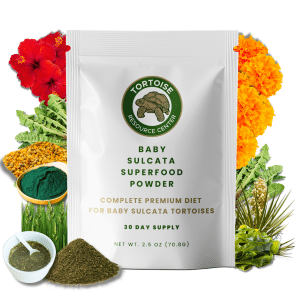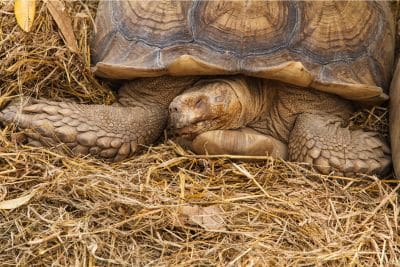There are a variety of tortoise husbandry tasks that you can schedule whenever you like. For example, you should replace your tortoise’s full spectrum lights every six months or so, but it doesn’t matter what month of the year you choose to do so. But other tasks must be scheduled at specific points on the calendar.
This includes things like hibernation. In my experience, it’s best to schedule your tortoise’s hibernation period within a relatively well-defined window. For the purposes of this article, I’ll be laying out the timing of tortoise hibernation as well as explaining how to prepare for it. Read on to find out more.
Hibernation vs Brumation
So far in this article, I’ve been using the term “hibernation,” but it is important to point out that tortoises don’t actually hibernate like some mammals do; tortoises brumate, which is essentially the reptilian version of hibernating.
Instead of falling into a deep sleep like chipmunks, groundhogs, or other true hibernators do, tortoises simply become inactive during their winter dormancy period. In fact, wild tortoises occasionally become active and bask in the sun on unseasonably warm winter days.
The distinction between hibernation and brumation is certainly subtle, but it is something tortoise keepers should be aware of.
Nevertheless, from this point forward, I’ll use the term hibernation, as it is more familiar to beginner tortoise keepers. But understand that when your tortoise hunkers down for the winter, he is actually brumating rather than hibernating.
Tortoise Hibernation Timing
As with so many other aspects of tortoise husbandry, the proper hibernation timing for your tortoise will depend on whether you maintain your pet outdoors or indoors. Each approach will affect hibernation timing slightly differently, so I’ll address both separately.
Hibernation Timing for Tortoises Housed Outdoors
If you maintain your tortoise outdoors, you’ll have to time his hibernation to coincide with the seasonal changes in your area. The falling temperatures and change in day length will trigger his body to prepare for hibernation, and there’s no good way to override this process.
Most tortoises will begin reducing their activity level and eating less as the nighttime temperatures begin dipping into the low 60s Fahrenheit. By the time the ground temperatures reach 50 degrees Fahrenheit, most tortoises will start hibernating.
But you can’t simply wait for the temperatures to drop and the days to grow shorter – there are steps you’ll need to take before your tortoise starts hibernating, and you don’t want to be caught off guard. This is why it’s a good idea to research the daily temperature patterns of your region. You may still need to make some adjustments as the seasonal changes can vary slightly from year to year, but this will allow you to know the approximate time to start preparations.
Approximately three weeks before you expect the ground temperatures to hit the 50-degree range, you can initiate your hibernation preparations (which I’ll discuss later). As a general guide, temperatures in many areas will reach these levels in September or October. However, temperatures may not fall this low until November or December in the Deep South or along the southern West Coast.
Hibernation Timing for Tortoises Housed Indoors
In contrast to those who rear their tortoises outdoors, those who maintain tortoises indoors have more flexibility with regard to hibernation timing. You’ll still find that winter is the easiest time to carry out the hibernation process in most cases, but you can usually target a specific date that works best for you.
This provides several clear advantages.
For example, some keepers may wish to have their eggs hatch the next season before competing breeders do. So, they’ll start the hibernation process as early as possible. Others may want to eliminate as many tortoise husbandry tasks as possible during the busy holiday season, so they schedule the peak of hibernation to occur during late December and early January.
But no matter when you decide to initiate hibernation, it is crucial that you only do so after properly preparing your tortoises for the event.
Preparing Tortoises for Hibernation
You can’t simply start hibernation on a whim; you have to prepare your tortoises for the long period of dormancy.Here below are the steps you’ll need to take:
Ensure Your Tortoise Is Healthy
Sick tortoises should never be hibernated. As tortoises enter dormancy, their immune systems stop functioning at peak levels, which can allow existing illnesses to spiral out of control.
So, examine your pet closely in the weeks before hibernation and note any potential signs of illness. It is also wise to visit your veterinarian to obtain a clean bill of health.
Your vet may recommend having a fecal analysis performed (to check for the presence of parasites), analyzing your pet’s blood to monitor organ function, or taking X-rays to ensure that your tortoise isn’t suffering from bladder stones.
Are You Starving Your Tortoise?
Save 10% on premium tortoise food and supplements from Tortoise Resource Center on Amazon now using code BUYNOWGET10

Sulcata Vitamin & Mineral Topper Supplement
30-Day Supply | 2 oz (56 g)
$24.99

Baby Sulcata Tortoise Superfood Powder
30-Day Supply | 2.5 oz (70.8 g) Bag
$24.99
Empty Your Tortoise’s Digestive Tract
Once satisfied that your tortoise is healthy, you can begin the next step of hibernation preparation: fasting.
You cannot hibernate tortoises with full stomachs. Doing so may cause any food in your tortoise’s digestive system to decay faster than it can be digested. This may cause your tortoise to become seriously ill or even die.
So, while many keepers feed their tortoises heavily in the weeks and months leading up to hibernation to ensure sufficient fat stores are present, it is imperative that you withhold food for approximately two weeks before initiating the hibernation process. This will help ensure that your tortoise’s intestinal tract is empty.
Make Sure Your Tortoise Is Properly Hydrated
You’ll also need to ensure that your tortoise is adequately hydrated before allowing him to hibernate. The best way to do this is by initiating a daily soaking regimen for a week or two before the scheduled start of hibernation.
Soaking will also encourage your tortoise to defecate, further helping to empty his digestive tract.
Preparing a Hibernaculum
In addition to preparing your tortoise’s body for hibernation, you must also prepare the place in which he’ll wait out the winter. This place is called a hibernaculum.
Preparing a Hibernaculum for Indoor Tortoises
If you’re allowing your tortoise to hibernate indoors, you can simply use a plastic storage box, half-filled with substrate. Be sure that you add a few ventilation holes to provide air exchange and insert a thermometer probe that’ll allow you to monitor the temperatures in the hibernaculum.
You can then place the hibernaculum in a cool spot. Some keepers keep their pet’s hibernaculum in a garage or basement, while others use a refrigerator. A word of caution here: don’t use the refrigerator in which you keep your family’s food! You’ll need to set up a separate refrigerator for hygiene’s sake.
No matter where you place the hibernaculum, you’ll want to ensure the temperatures remain between about 37- and 44-degrees Fahrenheit. Temperatures lower than this may cause your tortoise to freeze; temperatures above this range will prevent your pet’s bodily functions from slowing enough to allow true dormancy.
Preparing a Hibernaculum for Outdoor Tortoises
There are a few different ways to provide a hibernaculum for outdoor-reared tortoises.
Some keepers dig a burrow or allow their tortoises to dig a tunnel, which then serves as the hibernaculum. Others use a storage box filled with substrate like the keepers of indoor-reared tortoises do.
Some may even bring these storage boxes indoors during hibernation. No matter which option you select, just be sure to keep your tortoise within the 37- to 44-degree temperature range, mentioned earlier.
This can prove very challenging for keepers who keep their tortoises outdoors during the winter. And if the temperatures start to fall outside this range, there aren’t many things you can do – you’ll likely need to break your pet’s dormancy and bring him indoors, which may thwart any future planned breeding attempts.
Accordingly, it is typically a good idea to have a trial run the year before you intend to hibernate your tortoise. This will give you the time to experiment with different hibernaculum designs and prepare yourself for the next winter.
The End of Hibernation: Waking Your Tortoise Up
While wild tortoises may hibernate for half the year, most tortoise keepers try to provide an 8- to 12-week hibernation period, but the exact hibernation duration depends on the species and climate in which they live. However, if you’re keeping your tortoise outdoors, you may have no choice but to allow your tortoise to remain dormant until warm weather returns.
When attempting to end an indoor-reared tortoise’s hibernation period, be sure that you do so gradually. Slowly raise the temperatures and increase the length of time the enclosure lights are on. Your tortoise will likely start resuming normal activity slowly, as “spring” arrives.
Many keepers like to initiate a regular soaking routine following the end of hibernation. This helps ensure your pet is hydrated, and it may also encourage activity.
Your tortoise may not resume feeding immediately, but that’s not cause for concern. It can take a few days for his appetite to return. However, if he hasn’t eaten food by the end of the first week, it’s a good idea to speak with your vet.
Citations
- South Carolina Aquarium – Reptile Brumation
- Arizona Exotic Animal Hospital – Hibernation Recommendations for Turtles and Tortoises
- Tortoise Trust – Refrigerator Hibernation for Tortoises & Turtles


